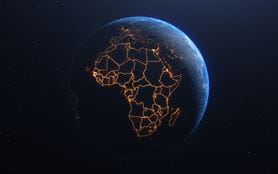Spotlight on Lusophone trends in Africa: Economic development and energy transition – how do you strike the right balance?
Related people
Headlines in this article
Related news and insights
News: 05 February 2024
Publications: 27 July 2023
Deregulating South Africa’s electricity market – Where to start? Where to next?
Publications: 12 June 2023
Interview with Urvi Gudka: In my heart I will always be an African, first and foremost
Striking a balance
Lusophone countries across Africa are at different stages of economic development but here, as is the case right throughout the continent, energy transition is on everyone’s agenda. That involves investing in a range of renewable technologies, including hydro power, solar, wind and biomass and, as the transition picks up, we are likely to see a diverse roster of projects being funded.
At the same time, even the wealthiest and most developed economies need to invest very heavily in supporting infrastructure to make sure people have access to power, which remains a significant challenge.
This calls for investment not just in power generation but in transmission and distribution capacity to connect people to electricity and in other crucial infrastructure projects such as road, rail and ports.
For a country like Mozambique, this will involve massive investment in new infrastructure. In Angola, which is a richer and more developed economy, it’s more about overhauling and modernising infrastructure.
In both cases, however, there is still a need to exploit rich natural fossil fuel resources, particularly oil and natural gas, to finance the energy transition and wider economic development. The dependence on fossil fuels will diminish, but it will take some time. For now, it’s all about trying to strike a balance.
Mozambique continues to focus on LNG
The main focus in Mozambique is definitely on gas, and LNG in particular. With some 100 trillion cubic metres of natural gas reserves, the country has the third largest proven reserves in Africa.
The successful closing of the Coral South Floating LNG (FLNG) financing in 2017 marked a major turning point for the country. The USD5 billion deal, on which we advised a range of export credit agencies and commercial lenders, was the world’s first project financing for an FLNG project, Mozambique’s first LNG investment and Africa’s largest ever project financing.
The project, operated by a consortium that includes Italy’s ENI, ExxonMobil, Galp and the state-owned energy company ENH, is proving successful. The giant installation, built in South Korea, was floated into position in Area 4 of the Rovuma basin, 31 miles off the coast of Northern Mozambique last year and shipped its first LNG cargo in November. It is expected to have the capacity to liquefy 3.4 million tons of gas a year.
Two further onshore developments have been delayed due to security instability in the Cabo Delgado region. Despite the hold up, the security situation appears to have improved and there have been some positive indications that development will start again fairly soon, although the precise timing remains to be seen.
Meanwhile there has been some press speculation that sponsors may seek approval to build a second offshore facility, given the success of the first.
These developments have put Mozambique on the map as a major player in the global LNG market, at a time when the Ukraine conflict has seen a spike in demand for gas from sources other than Russia. Developing the natural gas resources should provide revenues over the next 10 to 15 years to help finance Mozambique’s wider economic development and transition to clean energy.
Mozambique’s renewables challenge
Mozambique currently produces more electricity than it consumes, and it exports power to neighbouring countries, including South Africa. Some 77% of power is currently produced by hydro projects and we are seeing continued investment in this technology. The modernisation of the giant Cahora Bassa Dam, the largest hydroelectric scheme in southern Africa, is expected to be completed in 2025, while a new mega-hydro project at Mphanda Nkuwa is due to be completed in 2031.
However, Mozambique remains highly climate challenged and susceptible to drought, making this heavy dependence on hydro potentially problematic. For that reason, there is growing interest in developing solar projects, both large-scale (including the proposed 300MW solar PV and battery energy storage system project in the Tete Province) and relatively small off-grid solutions in rural areas to power schools, public buildings and homes.
Investing in energy supplies that are more diverse will also require heavy investment in transmission and distribution. Although the country exports electricity, domestic access to power remains patchy, with just over a third of the population connected to power.
The government’s National Electrification Strategy includes a commitment to provide universal access to power and is likely to involve opening the market to independent power producers, a trend we have also seen in South Africa.
Similar challenges in Angola
Angola is a more developed economy thanks to its massive oil and gas reserves, which it has been exploiting for many years. It is Africa’s second largest oil producer after Nigeria, with oil and gas accounting for over 90% of its exports.
But, despite its wealth, it faces some similar challenges. Less than half the population has access to power and in rural areas it is under 10%. Losses from an electricity grid in need of modernisation are estimated to be running at 35%.
So we are seeing a big push to invest in renewables, with the government targeting 80% renewable power by 2025. Renewables currently account for 56% of the energy mix, with a number of big hydro projects either recently developed or under construction, boosting capacity. There is also a push to invest much more in solar under a national development plan that also includes wind, biomass and mini-hydro schemes.
At the same time, we are seeing increased investment in related infrastructure projects, including road, rail and ports. A great example is the privatisation and development of the Port of Lobito and the 1,300km Benguela rail corridor stretching through the Democratic Republic of Congo and into the mineral-rich regions of Zambia. In total, six ports along Angola’s long Atlantic seafront are being upgraded, including at Namibe and Luanda, with new capacity also being added at Barro do Dande.
Attracting international investment
Market reforms and the restructuring of public companies carried out by the government in recent years have encouraged investors to look again at Angola and we are seeing a more diverse spread of investors looking for opportunities. Once heavily dominated by Chinese investors, there is now potential for increased Japanese, Middle Eastern and European investment.
Can Angola join the green hydrogen race?
Six countries have formed the African Green Hydrogen Alliance – Egypt, Kenya, Morocco, Mauritania, Namibia and South Africa. Although Angola is not yet part of the Alliance, it has stated its ambition to start exporting green hydrogen in the form of ammonia in 2025. The national oil company, Sonangol, has, for example, signed agreements with German partners to build a green hydrogen plant at the port of Barro do Dande.
Its ability to become a major player in this sector will depend on the development of renewable energy plants and access to desalinated or treated water.
It may also face challenges around building renewable plants to support what would largely be an export business with Europe as a main target, when the country is still struggling to connect large parts of its population to electricity. Accusations of resource colonisation have arisen in countries much further on in developing a green hydrogen industry, so it will be important to make sure developments also provide tangible benefits for the domestic market.
Trends in smaller Lusophone countries
The need to make the transition to clean energy is just as urgent in island jurisdictions, like Cape Verde and São Tomé, although projects are obviously on a smaller scale than in Angola and Mozambique.
The São Tomé government has set a target to increase the proportion of renewable energy from just 5% today to 50% by 2030 with investment mostly focused on solar and hydro schemes, with the possibility to explore wave and tidal technologies as these become more affordable. The country has set a 68% target for 2050.
Access to electricity is actually better here, but over 90% of São Tomé’s energy is currently generated from imported diesel, the cost of which has skyrocketed thanks to the impact of the war in Ukraine.
Cape Verde faces a similar dilemma, depending on expensive imported oil for the generation of 80% of its electricity. It is now accelerating the transition to renewable energy with investments in both wind and solar power that are scheduled to add some 40MW of new capacity by the end of 2023, supported by measures to increase energy efficiency and reduce transmission losses.
These investments should boost renewable energy generation to 30% by 2025, with a goal to reach 50% by 2030, although the government has expressed confidence that this target may well be met earlier.
Cautious optimism
There are clear reasons to be cautiously optimistic about the prospects for energy transition and economic development across Lusophone countries, particularly as international investors show greater willingness to back projects in these important markets. There is a growing sense of confidence in the investment community.
But for all the progress we are seeing, it’s important to be clear – there is still much, much more to do and many challenges lie ahead.
Filipa Serra is a senior associate in Allen & Overy’s Projects, Energy, Natural Resources and Infrastructure practice and heads the firm’s Lusophone Desk.

